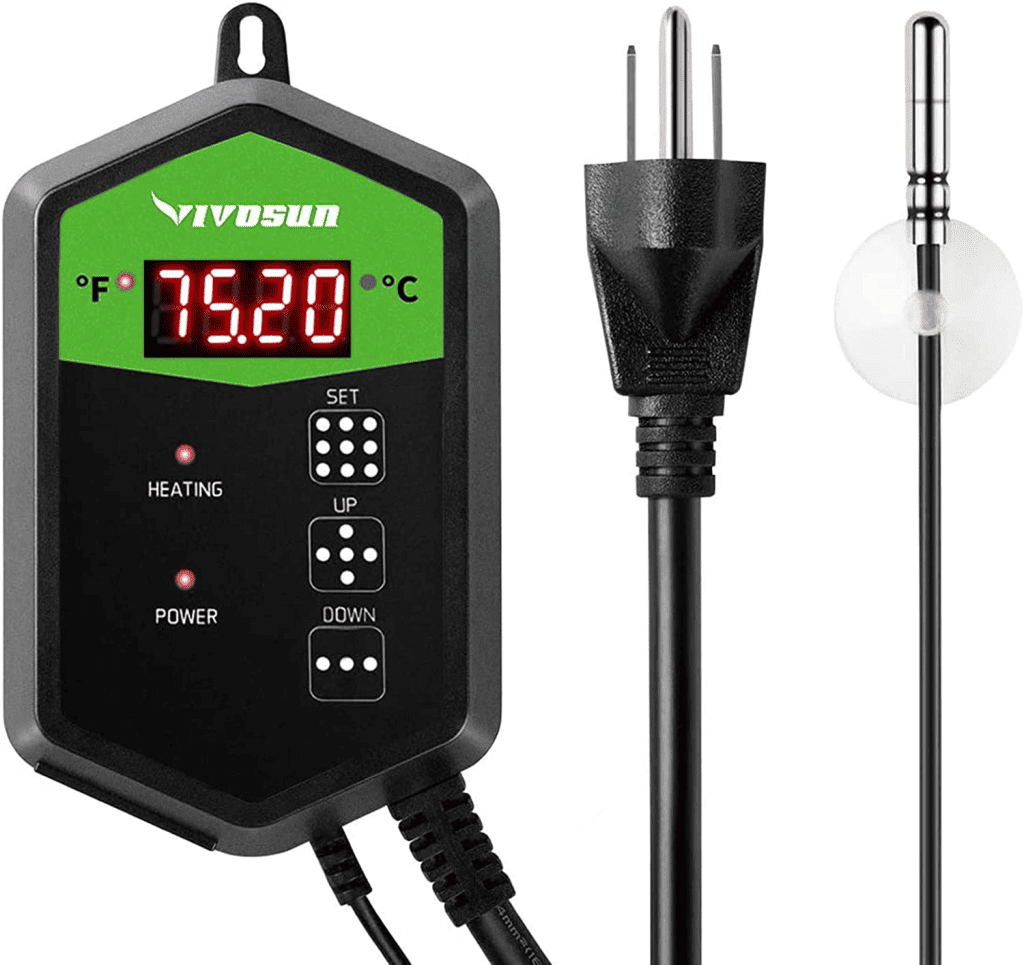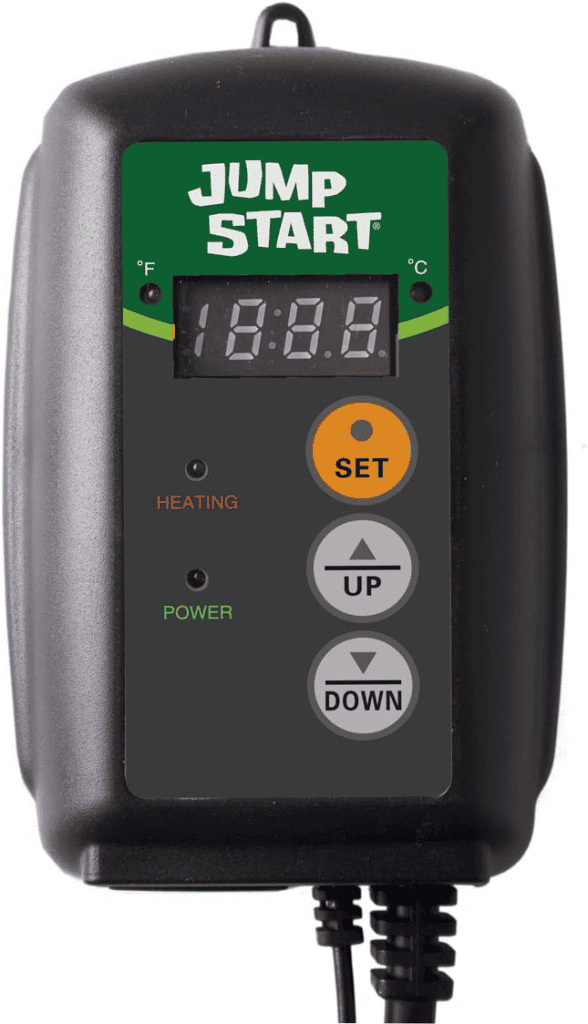Reptiles are amazing animals to keep as pets. However, each species has specific temperature needs to thrive and survive. If you do not maintain the right temperature, your reptile will die or develop different problems, such as digestion issues or immune deficiencies. As a pet owner, you need to maintain the required temperature inside the vivarium or tank enclosure. You can achieve this with the best heat lamp thermostats.
Best Heat Lamp Thermostats
There are different types and models of reptile thermostats available. Choosing the best one can be quite challenging. With this list of reptile thermostats, you can get one that suits your needs.
Inkbird ITC-308
The Inkbird ITC-308 is one of the widely used thermostats in the amphibian and reptile-keeping hobby. It has a heating element that helps maintain the required temperature within a reptile’s enclosure. Other than using it in herptile husbandry, you can use it for other applications, such as home brewing, germination, pet breeding, and incubation.
Features
Temperature Calibration
This thermostat is designed to allow temperature calibration to deliver precise temperature controlling and monitoring. Thus, you can use it for monitored reptiles.
Temperature Alarms
This thermostat supports alarms for high-and-low temperatures, abnormal temperatures, and continuous heating. Thus, it is safer for better for monitoring your reptiles.
Dual Relay Output
This thermostat controls both heating and refrigeration equipment concurrently to ensure the high working efficiency.
Easy-to-Use
The Inkbird ITC-308 has been designed for plug-and-play. Additionally, it is easy to use, easy to store, and easy to move.
Pros
- Easy to use
- Safe to use with an automatic shutoff feature
- Dual display window
- Wi-fi connectivity
Cons
- A bit noisy
Zilla 1000w
The Zilla 1000w is designed to regulate terrarium temperatures from heating devices. You only need to place the temperature probe inside the reptile tank and connect the unit to the heat source. It automatically turns on and off until the right temperature is achieved. This thermostat is ideal for use with various heat lamps, pads, domes, and emitters. However, it should not be used with heat rocks.
Features
Temperature Control
This reptile thermostat provides you with adequate temperature control. Ideally, you can control up to 3 heaters with one unit.
Simple to Use
It is quite easy to use this thermostat. You only need to set the right temperature and the system will run continuously.
Pros
- Lengthy cables
- Easy to use
- Can control up to 1000W
Cons
- Difficult to find the analog version
VIVOSUN Thermostat
The VIVOSUN Thermostat is one of the best heat lamp thermostats currently available on the market. If you need reliable results, this is the thermostat you can rely on. It maintains and regulates your desired temperature from 40 to 108 degrees Fahrenheit.
Features
High-Quality Construction
This reptile thermostat is made of extra-fortified plastic components that do not malfunction or rust even under extreme conditions.
Hanging Tab
The hanging tab is a worthy feature to mention. It allows you to hang your thermostat anywhere you want.
3 Prong Outlet
This feature ensures your cords do not get tangled.
Suction
The thermostat comes with a suction cup that allows you to stick it to the terrarium or wall.
Reptile Warmer
This thermostat is compatible with any given heat map. With all these, you can create a comfortable and warm growth environment for the reptile during cold winter.
Easy to Set Up
Although this thermostat comes with a user manual, you might not even need it. You can easily change the display and set your desired temperature using only 3 buttons.
Pros
- Safe to use
- Adequate temperature range
- Simple to use
- Support up to 1000W
- Higher accuracy
- Ability to hang
Cons
- The lowest temperature setting is 68F
Exo Terra 100w Thermostat
The Exo Terra 100w Thermostat allows you to create a controlled heating environment. Ideally, you can recreate conditions that are similar to those you can find in a tropical, rainforest, or desert environment. Also, it allows you to prevent undercooling and overheating during cold winter nights and hot summer days.
Features
Electronic Triac Switch
This is an important switch that allows you to control your desired temperature with higher accuracy than most traditional thermostats. Thus, you can forget temperature fluctuations in the terrarium. Make sure you set the temperature based on the needs of your animal.
Simple to Use
You only need to connect it to the heat map, cable, or heater and set your preferred temperature.
Safe to Use
It has a Red LED indicator which shows that your heating device is functioning. Once the preferred temperature is achieved, it shuts off. Additionally, it prevents accidental temperature changes.
Excellent Durability
Its waterproof remote sensor is suitable for use in aquatic environments and terrariums.
Pros
- Lengthy cables
- Simple to use
- The temperature sensor is waterproof
- Made of quality materials
Cons
- Low-temperature range
Jump Start Thermostat
The Jump Start Thermostat is designed to provide bottom heat for your terrarium. This ensures your reptiles enjoy their desired temperatures by precisely maintaining and controlling heat output. It can also be used for other hobbies such as homebrewing, and germination. The digital temperature control makes it easy to read and set temperature.
Features
Heavy-Duty Applications
You can use this thermostat for larger projects. Always use mega-sized heat mats to ensure uniform heat for multiple reptiles.
Durability
This thermostat comes with rugged, durable, and waterproof connectors to ensure it lasts for a long.
Terrarium Warming
You will find this thermostat suitable for pet enclosures and terrariums. When you use it with appropriate heat mats, you can provide the desired level of warmth for your reptile pets to grow.
Pros
- 3-prong power outlet
- Easy to set up
- Controls up to 1000w
Cons
- A bit expensive
Buyers Guide
There are various things to consider when choosing a reptile thermostat. The most important thing is to ensure you get a thermostat that suits your reptile’s unique needs.
Different Types of Heat Lamp Thermostats
Simple on/off the thermostat
This is the simplest type of heat lamp thermostat. It turns on or off the heating element depending on the temperature inside the vivarium or enclosure. Its temperature sensor reports the actual temperature and when it is higher than the desired one, it turns off the heater. Likewise, if it is lower than the desired level, it turns the heater on.
These thermostats are more effective when used with heat pads/heat mats. They are used with ceramic heat bulbs or heat emitters.
Dimmer Thermostat
This type of thermostat provides much more functionality than its on/off counterpart. Hence, it is more expensive. It works continuously with the sensor that measures the temperature of the tank. It will then signal the heater to increase the temperature whenever it drops or reduce it when it is at the maximum level.
Pulse Thermostat
Although this thermostat is not meant to be used with light bulb heaters, it is suitable for heat mats and ceramic heaters. It sends rapid energy pulses to the heater to lower or increase the temperature until the desired levels are attained.
Things to Consider While Buying a Reptile/Heat Lamp Thermostat
Temperature Range
Before buying a heat lamp thermostat, you need to check the temperature range it provides. The right one should be within your ideal temperature range. It is advisable to get a reptile thermostat that provides a wider temperature range as it allows you to keep different varieties of pets.
Ease of Use
What is the need for purchasing a thermostat that is confusing and complicated to use? Ideally, you should go for a thermostat that is simple to use and serves the intended purpose. If you are going to program your unit, it needs to be easy to program and operate. It is advisable to get digital thermostats as they are more accurate and easier to use than their analog counterparts.
Safety
You should get a reptile thermometer that is safe to use. Accuracy, ease of use, and computability do not matter if the device is unsafe. Check whether your thermostat is made of durable materials and it should not cause wild temperature fluctuations that are dangerous to your reptile.
Type of Reptile
You need to consider the type of reptile you are keeping. What is the ideal temperature range of your reptile? Do you plan to use your thermostat to control the temperature of different types of reptiles? Does your reptile require any special considerations as far as heating and cooling are concerned? Those are some of the questions you should answer when determining whether your heat thermostat suits the needs of your reptile.
Display
Thermostats can have either analog dials or digital displays. The digital screen displays the temperature inside the enclosure. You can also program your ideal temperature range on display. Analog displays are simple to use and are reliable like digital thermostats.
Noise Levels
Thermostats produce some levels of noise. You should avoid noisy reptile thermostats as they can annoy you and your pet. Although most of these units are quiet, you should double-check before buying.
Price
There is a need to consider the price of your reptile thermostat. Usually, you buy what you get. It is advisable to spend more on a thermostat that provides all the important features you need.
Wrapping Up
The best heat lamp thermostat will help you regulate and control the temperature range of your reptile’s enclosure. Without one, you will need to control the temperature manually. Unfortunately, this requires a lot of hard work on your part. With the right thermostat, the work will be done for you. No matter the reptile you keep, there is a thermostat that works for you. You cannot go wrong with the above list of heat lamp thermostats.
FAQs
Where Should a Reptile Thermostat Be Located?
You should place your reptile thermostat in the area you want to control and regulate the temperature. The ideal place is under the heat source where your reptile likes to bask.
What Does a Reptile Thermostat Do?
Other than monitoring and regulating the temperatures inside the enclosure, it helps protect your reptile against overheating, which is the leading cause of reptile fatality.
Do Reptile Heat Lamps Consume a Lot of Electricity?
Most reptile owners report an average of five dollars a month. This is because most of the bulbs run at 70 to 150 watts per hour.






Comments are closed.